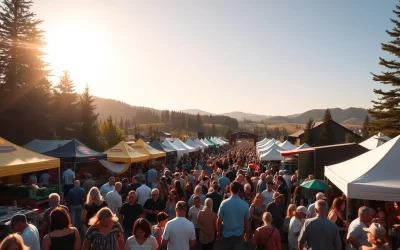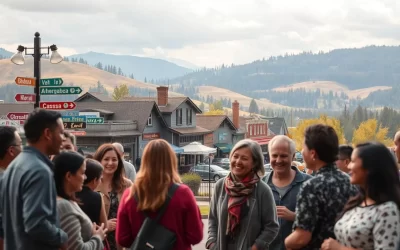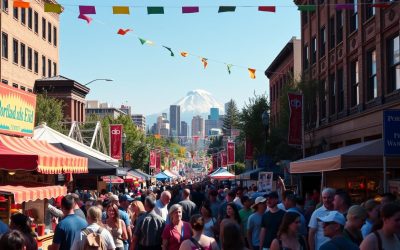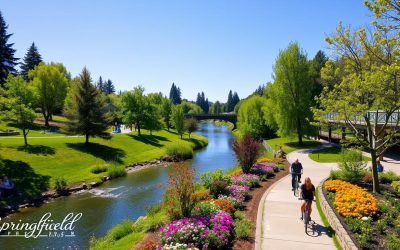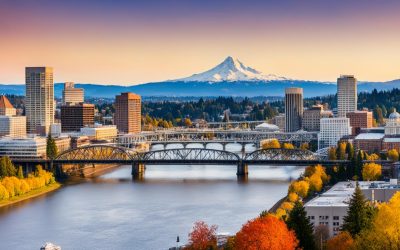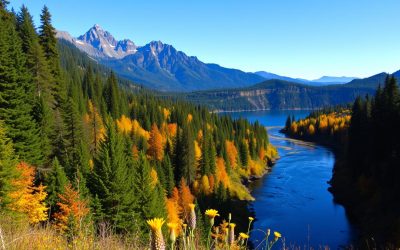Planning a trip to Portland, Oregon, and wondering when to go? The weather is a crucial factor in making your trip memorable.
The Pacific Northwest gem is known for its unique blend of urban charm and natural beauty. To make the most of your travel experience, understanding the weather patterns is essential.
Whether you’re interested in outdoor activities, cultural experiences, or visiting the famous Willamette Valley wine country, knowing the best time to visit is key. The region’s diverse climate zones mean that the time to visit varies based on your preferences.
From the rainy Pacific Northwest coast to the high desert in the east, Oregon’s diverse landscapes offer a range of experiences. Summer offers warm, sunny days, while spring and fall provide milder temperatures and fewer crowds.
Understanding Oregon’s Diverse Climate
From the wet coastal regions to the dry high desert, Oregon’s climate varies significantly across its seven distinct regions. This diversity in climate is a result of the state’s varied geography, which includes rugged coastlines, mountains, and high deserts. As you plan your trip to Oregon, understanding these climate variations is essential to making the most of your travel experiences.
Pacific Northwest Weather Patterns
The Pacific Northwest, including Oregon, is characterized by a Mediterranean climate pattern. This means you can expect dry summers and cool, wet winters, especially in the western part of the state. The region’s weather is influenced by its proximity to the Pacific Ocean, which moderates temperatures and contributes to the significant rainfall during certain parts of the year. During the summer months, the dry conditions make it ideal for outdoor activities such as hiking and exploring the natural beauty of Oregon.
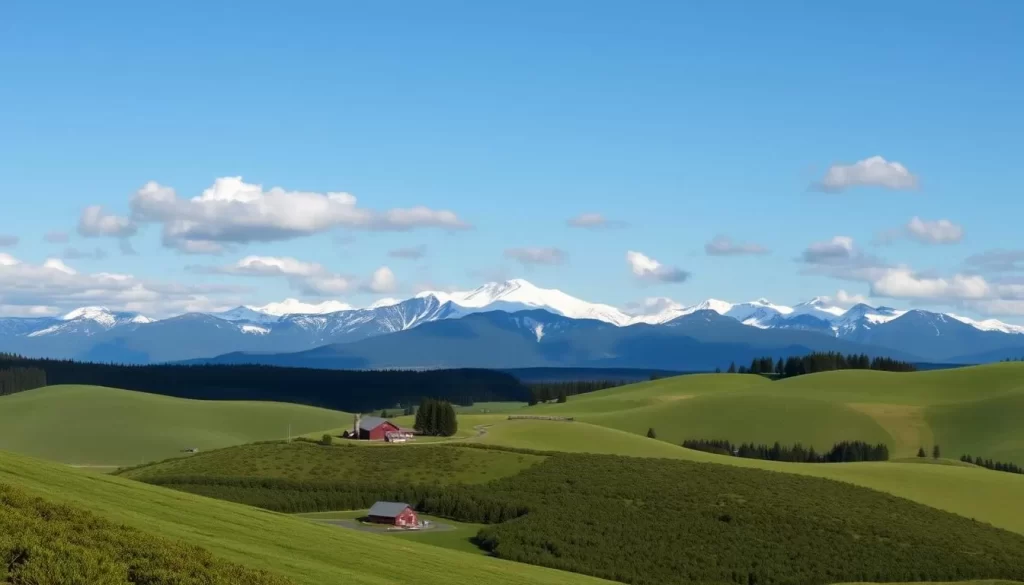
Regional Climate Variations Across Oregon
Oregon’s climate is not uniform; it varies dramatically from one region to another. The coastal areas tend to have milder conditions year-round, while inland areas experience more extreme temperature variations between summer and winter. The Cascade Mountain Range acts as a natural barrier, creating wetter conditions west of the mountains and drier conditions to the east. For instance, western Oregon receives significant rainfall, particularly from November through March, whereas eastern Oregon remains much drier. Understanding these regional variations is crucial for planning your Oregon tours and activities, ensuring that you make the most of your visit regardless of the time of year you choose to travel.
- The Willamette Valley enjoys warm months from June through September, making it the best time to visit for wine enthusiasts.
- Oregon’s diverse climate contributes to its rich cultural experiences and varied attractions, from vineyards to snow-capped mountains.
- The state’s varied climate zones offer a range of experiences for visitors, making it a versatile destination for travelers.
Portland’s Mediterranean Climate: What to Expect
The Mediterranean climate in Portland, Oregon, offers a unique blend of warm, dry summers and cool, wet winters, ideal for various outdoor activities. This climate makes Portland an attractive destination for those who enjoy outdoor activities throughout the year.
Warm and Sunny Summers
Portland’s summers are warm and sunny, with an average temperature of 71 degrees Fahrenheit. The city enjoys approximately 144 sunny days annually, making it perfect for exploring the numerous parks, gardens, and trails. The dry summers are particularly conducive to outdoor activities like hiking, biking, and visiting the Portland Japanese Garden or the Lan Su Chinese Garden.
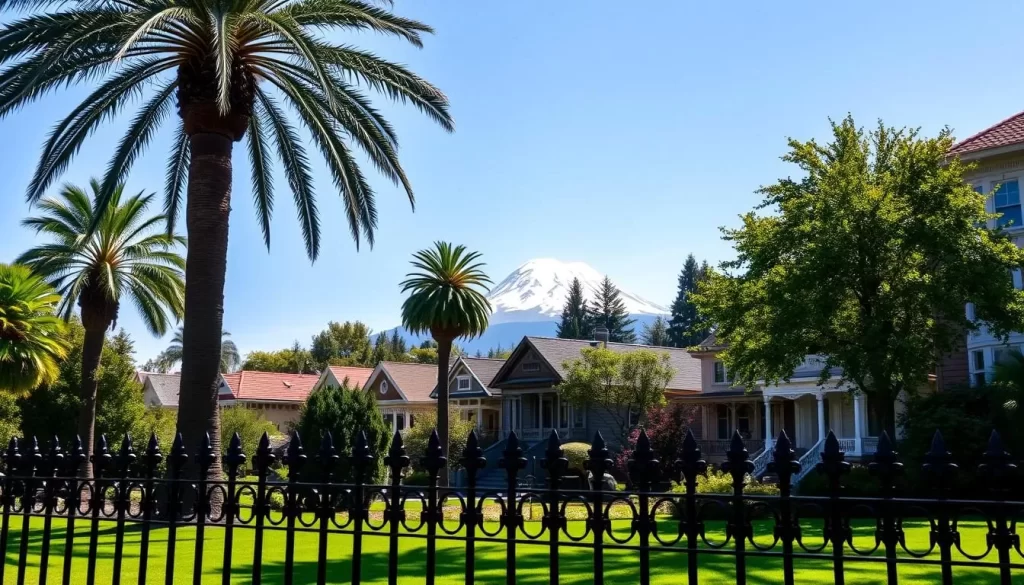
Moderate Rainfall Patterns
While Portland is known for its rain, the rainfall is generally moderate and gentle. It rains on about 164 days per year, with an annual average of 42 inches of rain. The rain is rarely in the form of heavy downpours, making the city’s green landscapes flourish without the harsh weather conditions associated with heavier rainfall.
Long Growing Season Benefits
One of the significant advantages of Portland’s climate is its long growing season of 280 days. This extended growing season supports the region’s agriculture and contributes to the lush urban landscapes. The favorable climate allows for a wide variety of plants to thrive, making Portland’s gardens and parks particularly vibrant.
Understanding Portland’s Mediterranean climate helps you plan your visit according to your preferences, whether you’re looking for outdoor activities in the summer or exploring the city’s gardens during the mild spring and fall seasons.
Summer in Oregon: Peak Season for Outdoor Adventures
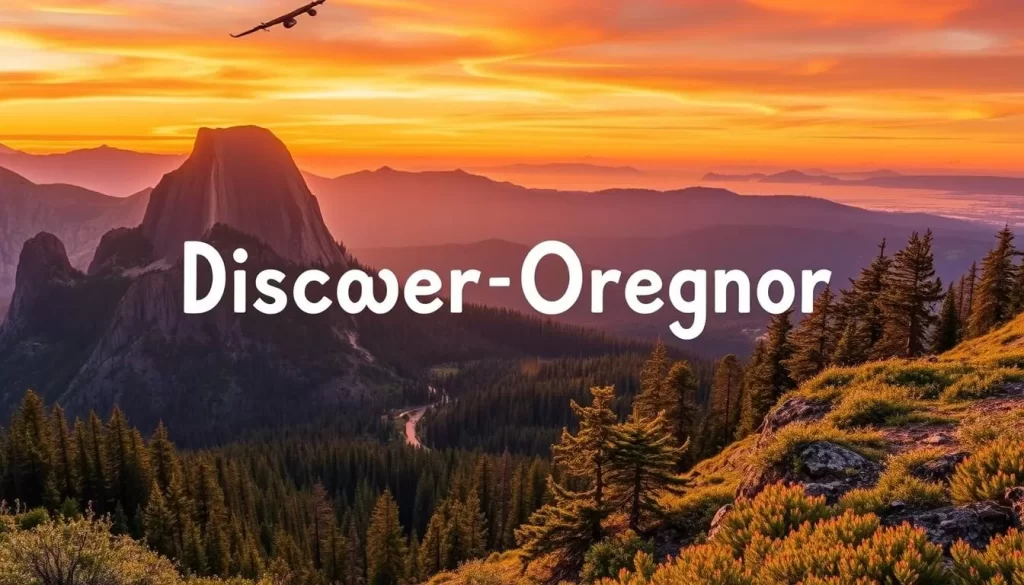
If you’re planning a trip to Oregon, summer is a great time to explore its natural wonders. The state’s diverse landscapes, from the Columbia River Gorge to the coastal beaches, are particularly inviting during this season.
June Through August: Weather Highlights
Summer in Oregon, spanning from June to August, is characterized by warm and sunny weather, making it ideal for outdoor activities. Temperatures typically range from 75-85°F (24-29°C) in Portland and the Willamette Valley. The International Rose Test Garden is a must-visit during this time, with over 10,000 rose bushes in bloom.
Benefits of Visiting During Summer Months
Summer offers numerous benefits for visitors, including the opportunity to enjoy Oregon’s natural beauty at its peak. You can hike in the Columbia River Gorge, visit Crater Lake National Park, or explore the scenic coastal routes. The warm weather also makes it an excellent time for wine tasting in the Willamette Valley.
The season is filled with outdoor festivals and events, such as the Portland Rose Festival and the Oregon Brewers Festival, showcasing the state’s vibrant culture.
Potential Drawbacks: Crowds and Prices
While summer is the best time to visit Oregon, it’s also the peak tourist season, which means larger crowds and higher prices for accommodations. Popular destinations like Portland and coastal towns tend to be busier, and heat waves can be a concern for some visitors. Planning ahead and booking accommodations early can help mitigate these issues.
Spring in Oregon: Cherry Blossoms and Vibrant Colors
Spring brings a burst of color and life to Oregon’s landscapes. As the season progresses, the state’s natural beauty is on full display, making it an ideal time for outdoor activities and sightseeing.
March to May Weather Conditions
During spring, Oregon’s weather is characterized by mild temperatures, ranging from 50-65°F (10-18°C), with rainfall decreasing as the season advances. Although occasional showers are possible, the overall conditions are pleasant for outdoor exploration.
Spring Outdoor Activities and Attractions
Oregon’s spring is perfect for enjoying the great outdoors. You can visit the International Rose Test Garden, featuring over 10,000 roses in more than 650 varieties. The Portland Japanese Garden is another must-visit, offering serene landscapes and cultural significance. For those who love hiking, Forest Park, the largest urban forest in the U.S., is a great destination.
Additionally, the Lan Su Chinese Garden provides a tranquil atmosphere, showcasing traditional Suzhou-style gardening. Cherry blossoms throughout the city add to the beauty, making Portland a picturesque wonderland in the spring.
Cherry Blossom Season in Portland
The cherry blossom season in Portland typically peaks in late March to early April, creating stunning displays throughout the city’s parks and along the waterfront. The Portland Japanese Garden is particularly magical during this time, with tranquil spaces to admire the blossoms against traditional Japanese architecture.
Fall in Oregon: Autumnal Beauty and Changing Leaves
With the arrival of fall, Oregon’s landscape is painted with a variety of colors, creating a breathtaking scenery. The air is crisp, and the mild weather makes it an ideal time to explore the state’s natural beauty.
September to November Weather Overview
During the fall season, Oregon experiences mild temperatures, ranging from 45-70°F (7-21°C). As the season progresses, the weather gradually cools down, with an increase in rainfall by late October and November. This makes September and early October particularly pleasant for outdoor activities.
Fall Foliage and Scenic Opportunities
Oregon’s city parks and gardens, such as the Lan Su Chinese Garden and Crystal Springs Rhododendron Garden, showcase stunning fall foliage. The changing leaves create perfect backdrops for photography and peaceful walks. You can also hike in Forest Park or take a scenic drive through the Columbia River Gorge and the Cascade Mountains.
Harvest Season in Willamette Valley
Fall is harvest season in the Willamette Valley, known for its world-class Pinot Noir. Visitors can experience the excitement of crush events and harvest festivals while sampling some of the best wines. The vineyards add their own golden hues to the landscape, making it a picturesque destination.
As you enjoy the fall season in Oregon, you’ll find that it’s not just about the autumn leaves; it’s also about the rich cultural experiences and outdoor activities available. From visiting the International Rose Test Garden to enjoying the harvest season in the Willamette Valley, there’s something for everyone.
Winter in Oregon: Rainy Season and Mountain Snow
As the calendar flips to winter, Oregon transforms into a state of contrasts, with rain-soaked valleys and snow-capped mountains. You can experience the best of both worlds, from the cozy indoor attractions in Portland to the thrilling winter sports at Mount Hood.
December to February Weather Patterns
During the winter months, Oregon’s weather varies greatly depending on the region. In Portland and the Willamette Valley, you can expect temperatures to range from 35-45°F (2-7°C), with an average rainfall of 5-6 inches per month. The rain is often light to moderate, with occasional breaks of sunshine, allowing for some outdoor activities between showers.
Indoor Attractions During Winter Months
Winter is an excellent time to explore Portland’s indoor attractions, such as world-class museums, theaters, craft breweries, and renowned restaurants. You can indulge in the city’s culinary scene, visit the Portland Art Museum, or catch a performance at the Oregon Symphony.
Winter Sports at Mount Hood
If you’re looking for winter sports, Mount Hood is a paradise for skiers and snowboarders. With six different ski areas and year-round skiing at Timberline Lodge, you can enjoy some of the best skiing in the Pacific Northwest. Whether you’re a beginner or an experienced skier, Mount Hood has something to offer.
Winter is also a great time to visit the Oregon coast, where you can enjoy dramatic storm watching, fewer crowds, and the chance to spot migrating whales from December through January. Additionally, winter accommodations often offer the best values of the year, making it an economical time to visit Oregon if you’re prepared for the rainy season.
Oregon, United States: Best Months for a Weather-Savvy Trip
Oregon’s varied weather patterns mean that the best time to visit depends on your preferred activities. Whether you’re looking for sunny days, vibrant festivals, or serene landscapes, timing your trip right is crucial.
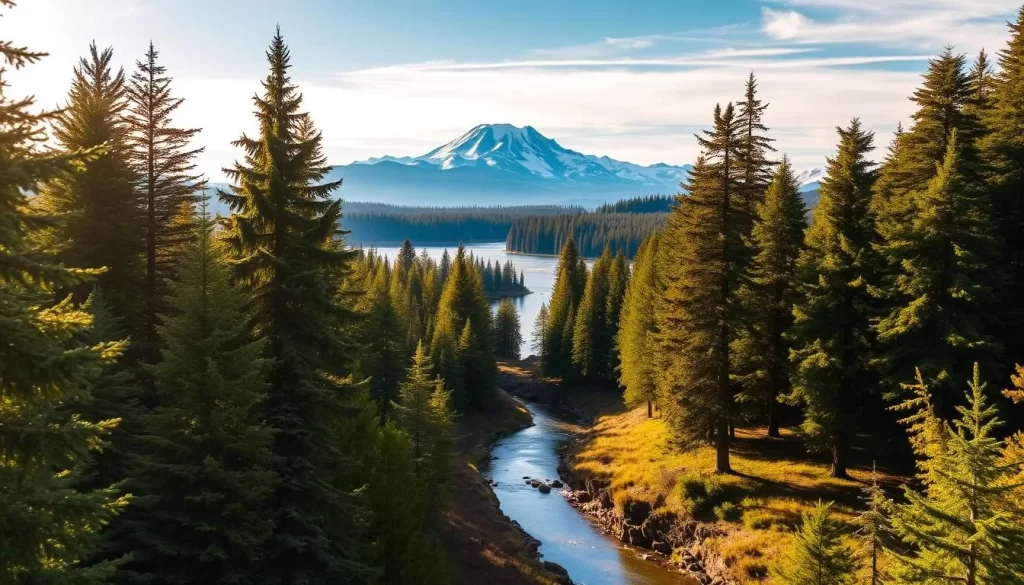
Top Weather Months for Different Activities
The best months for a weather-savvy trip to Oregon largely depend on what you want to do. For outdoor enthusiasts, July and August offer the most reliable sunny weather, making them ideal for hiking, camping, and exploring natural areas. If you’re interested in wine tasting, consider visiting the Willamette Valley in September or October during harvest season when the weather is pleasant and vineyards are bustling with activity.
For those who enjoy beach activities, July and August provide the warmest coastal temperatures, though it’s worth noting that the temperatures remain relatively cool, ranging from 65-70°F (18-21°C). If you prefer fewer crowds and lower prices, spring (April-May) and fall (September-October) are excellent compromise seasons with generally good weather.
Seasonal Highlights Calendar
Oregon’s calendar is filled with exciting events and activities across different seasons. Here’s a snapshot:
- Summer (June to August): Warm and dry days perfect for outdoor adventures and festivals.
- Spring (March to May): Cherry blossoms bloom, and the city comes alive with vibrant colors.
- Fall (September to November): Autumn leaves create a picturesque backdrop for exploring charming neighborhoods.
- Winter (December to February): Ideal for snow sports enthusiasts heading to Mount Hood or other mountain destinations.
Weather Considerations for First-Time Visitors
If you’re visiting Oregon for the first time, consider the month of September as a “sweet spot.” The summer crowds have dissipated, but the weather remains favorable across most regions of the state. This makes it an ideal time to explore without the peak season hustle. Be prepared for variable weather by packing layers, as conditions can change quickly, especially in the mornings and evenings.
By choosing the right time for your visit, you can ensure a memorable and enjoyable trip to Oregon, tailored to your preferences and activities.
Exploring the Columbia River Gorge: Seasonal Guide
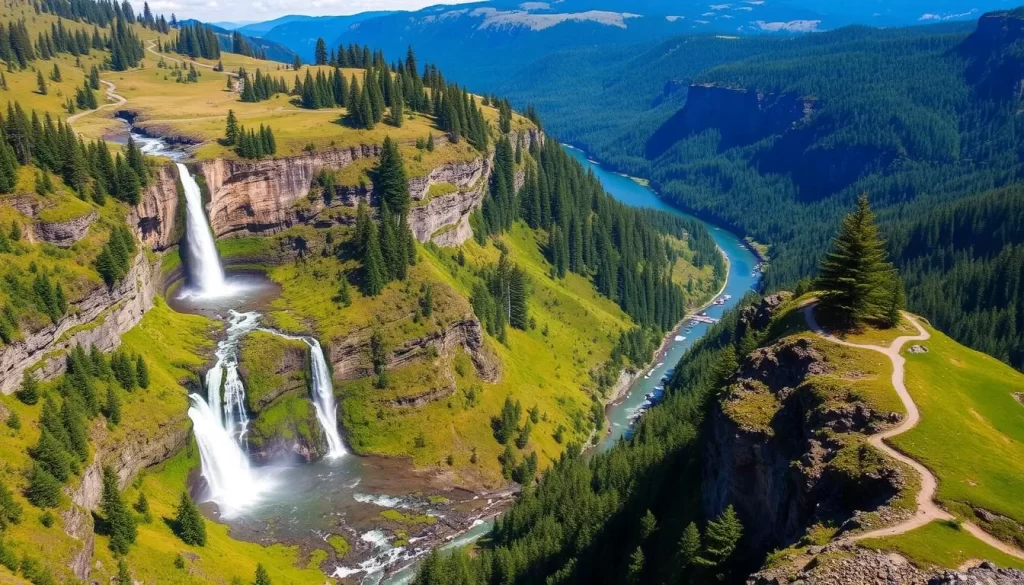
The Columbia River Gorge, stretching 80 miles along the Oregon-Washington border, is a year-round destination with seasonal highlights. This spectacular river canyon offers dramatically different experiences depending on when you visit.
Best Weather Windows for Hiking and Waterfalls
Late spring (May-June) is ideal for witnessing the most impressive waterfall displays as snowmelt increases water volume. Famous falls like Multnomah, Latourell, and Bridal Veil reach their most spectacular flows during this time. Summer (July-August) offers the most reliable hiking weather with dry trails and comfortable temperatures, making it perfect for outdoor enthusiasts.
Seasonal Attractions Along the Gorge
As the seasons change, so do the attractions along the Columbia River Gorge. Fall transforms the area into a colorful spectacle with vibrant autumn hues, typically peaking in mid-October. Winter brings a serene beauty with occasional snow dusting the landscape and fewer visitors, though hikers should be prepared for icy conditions. The eastern section of the Gorge experiences less rainfall, creating a sunnier microclimate even when Portland is rainy.
For photographers, early morning visits offer the best lighting conditions and fewer crowds at popular viewpoints and waterfall locations throughout the Gorge. Whether you’re hiking, sightseeing, or simply enjoying the views, the Columbia River Gorge is a must-visit destination in Oregon.
Willamette Valley Wine Country: Weather-Based Visit Planning
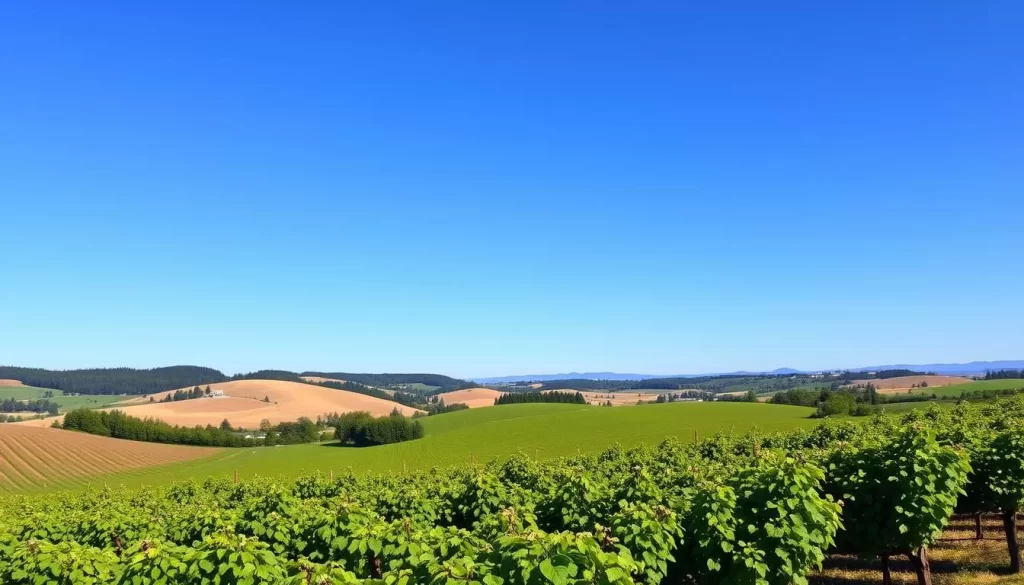
To enjoy the best of Willamette Valley’s wine tours, understanding the seasonal weather patterns is crucial. The Willamette Valley, known for its Pinot Noir and home to over 700 wineries, offers a distinct experience with each season.
Prime Seasons for Vineyard Tours
The summer months (June-August) are ideal for vineyard tours due to warm, sunny days averaging 75-85°F (24-29°C) and minimal rainfall. This creates perfect conditions for outdoor wine tastings and vineyard tours. Spring (April-May) is another great time, with beautiful flowering vines and fewer crowds, though visitors should be prepared for unpredictable weather with intermittent rain showers.
Wine Harvest Season Weather Considerations
During the harvest season (September-October), wine enthusiasts can witness the excitement of crush activities. However, the weather becomes more variable with occasional rain showers. For the optimal balance of good weather and authentic wine experiences, consider visiting during the “shoulder seasons” of late spring (May-June) or early fall (September).
Understanding the rain shadow effect from the Coast Range mountains, which results in approximately 40 inches of annual rainfall, can also help in planning your trip. By considering these weather factors, you can plan a more enjoyable and weather-savvy trip to Willamette Valley’s wine country.
Portland’s Diverse Neighborhoods: Year-Round Exploration
As you explore Portland, you’ll discover a city with a unique blend of urban charm and natural beauty. The city’s diverse neighborhoods offer a distinct experience throughout the year, each with its own character, attractions, and seasonal highlights that make year-round exploration rewarding.
Downtown and Pearl District Highlights
Downtown Portland is the heart of the city, offering a mix of commercial buildings, cultural attractions, and entertainment venues. You can explore the iconic Pioneer Courthouse Square, known as the “living room of Portland,” or visit the Portland Art Museum for a dose of culture. The Pearl District is known for its renovated warehouses, art galleries, and upscale boutiques. Take a stroll through Jamison Square Park or browse the unique shops and art galleries that line the streets.
Alberta Arts and Hawthorne Districts
For a bohemian and artistic vibe, head to the Alberta Arts District. Discover local art studios, vintage shops, and diverse culinary options. Don’t miss Last Thursday, a vibrant street fair that takes place on the last Thursday of every month. The Hawthorne District and Belmont area embody Portland’s quirky, bohemian spirit with vintage shops, independent bookstores, and diverse dining options.
Neighborhood Festivals by Season
Portland’s neighborhood festivals and farmers markets operate seasonally, providing excellent opportunities to experience local culture and cuisine. The city’s community spirit is on full display during these events, from the Alberta Street Fair in summer to holiday markets in winter.
| Neighborhood | Seasonal Highlights |
|---|---|
| Downtown & Pearl District | Summer: Outdoor dining and cultural events |
| Alberta Arts District | Last Thursday: Art walk and street fair (March to December) |
| Hawthorne District | Rainy-day exploration during winter months |
What to Pack: Seasonal Packing Guide for Oregon
Oregon’s diverse climate means you’ll need to pack differently depending on the time of year you visit. Understanding the seasonal weather patterns is crucial for a comfortable and enjoyable trip.
Summer Essentials
For summer visits (June-August), pack lightweight clothing, sunglasses, and sun protection. Although the days are warm and sunny, the temperature can drop significantly at night, especially along the coast, so a light jacket or sweater is advisable.
Spring and Fall Layering Strategy
During spring and fall, the weather can be quite unpredictable, with rain showers and sunshine occurring within the same day. It’s essential to pack versatile layering options, including light to medium-weight jackets, long-sleeved shirts, and a waterproof outer layer.
Winter Weather Gear
In winter, waterproof outerwear, warm layers, and waterproof footwear are must-haves. Even though snow is rare in Portland, the rain and chill can make it feel quite cold, so gloves and hats are also recommended.
| Season | Essential Items |
|---|---|
| Summer | Lightweight clothing, sunglasses, sun protection, light jacket or sweater |
| Spring/Fall | Layering options, light to medium-weight jackets, waterproof outer layer |
| Winter | Waterproof outerwear, warm layers, waterproof footwear, gloves, hats |

Conclusion
To make the most of your trip to Oregon, consider the weather and plan accordingly. Oregon offers exceptional experiences throughout the year, with each season providing its own unique charm and attractions for weather-savvy travelers. You can enjoy warm summer days, the beauty of spring, or the autumn leaves. While summer remains the optimal time to visit for reliable weather, spring and fall offer excellent alternatives with mild weather and fewer crowds.
Ultimately, the best time to visit Oregon depends on your personal preferences, budget constraints, and desired activities. With proper planning and appropriate packing, a memorable Oregon experience awaits in any season. Portland serves as an excellent home base for exploring Oregon, with its diverse neighborhoods and proximity to natural attractions.

